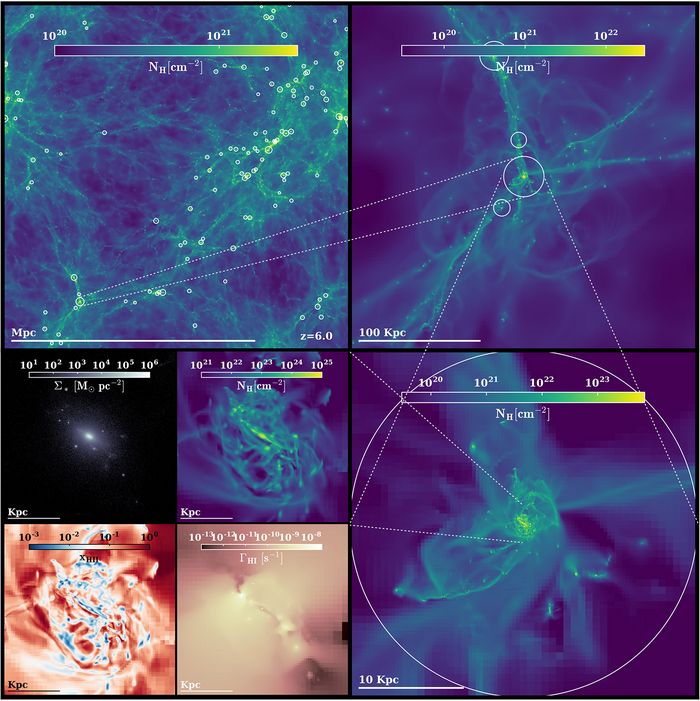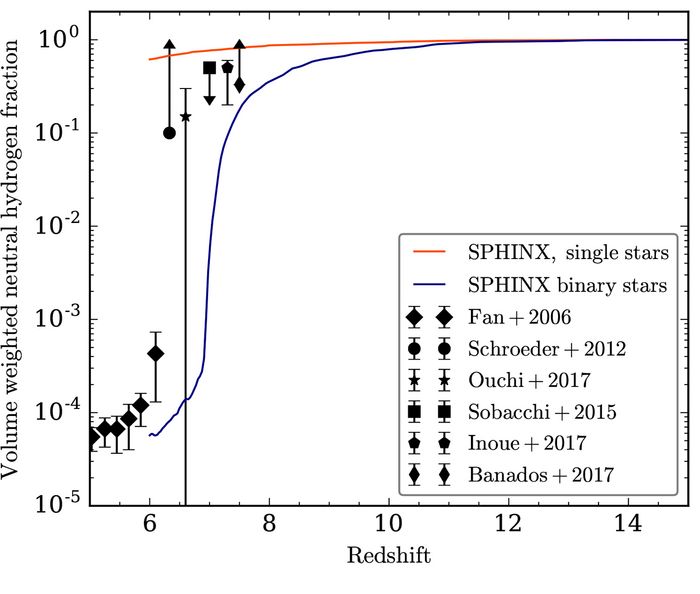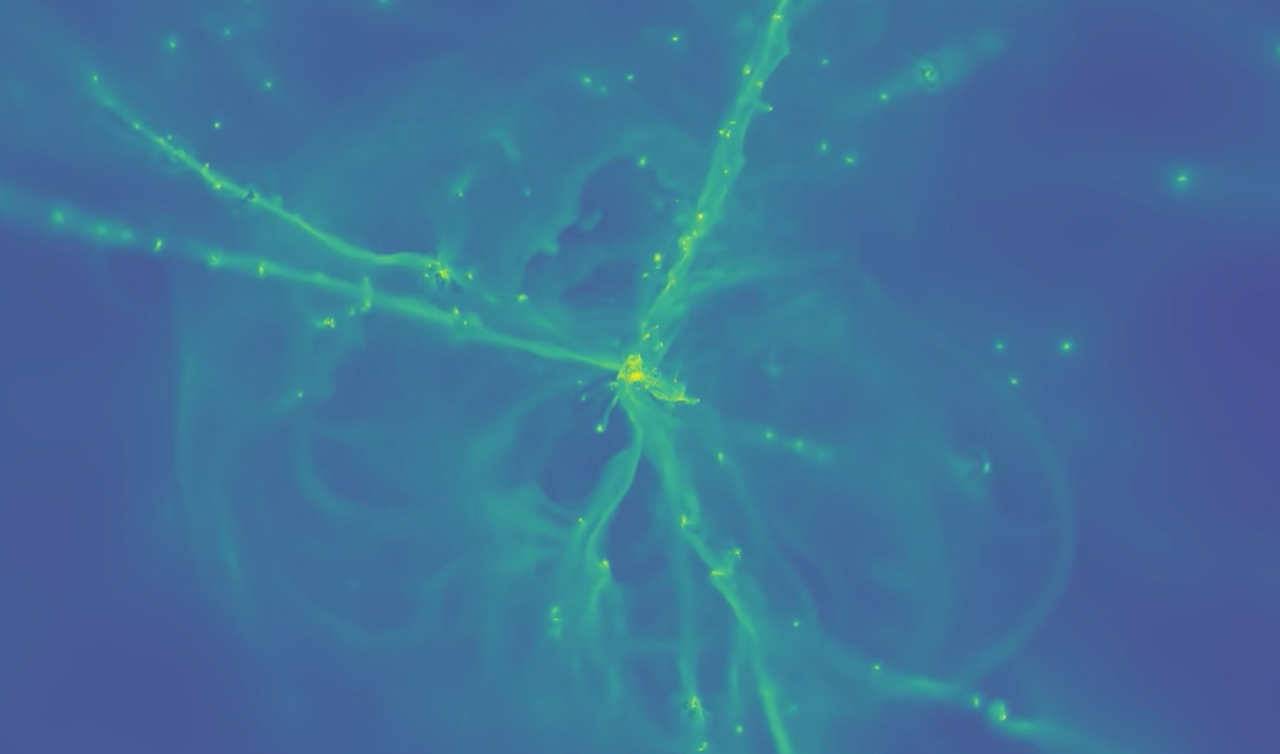ASTROPHYSICS
The SPHINX Simulations of the First Billion Years and Reionization
Principal Investigator:
Joakim Rosdahl
Affiliation:
Centre de Recherche Astrophysique de Lyon (France)
Local Project ID:
pr53na
HPC Platform used:
SuperMUC of LRZ
Date published:
ntroduction
The formation of the first galaxies marked the end of the cosmological dark ages and the beginning of the Epoch of Reionization (EoR). Radiation from the first stars, hosted by the first galaxies, heated the surrounding inter-galactic gas via photo-ionization. As the ionized hydrogen bubbles grew and percolated, the whole Universe was transformed from a dark, cold, neutral state into a hot ionized one: reionization was completed, about a billion years after the Big Bang. This last major transition of the Universe is at the limit of our observational capabilities and is a key science driver of the foremost upcoming telescopes, such as the James Webb Space Telescope (JWST) and the Square Kilometre Array (SKA).
Cosmological simulations are great tools to disentangle the complex physics leading to reionization, a `loop' encompassing an enormous range of physical scales: of gravitational collapse of dark matter into haloes, the condensation of gas into galaxies at the centres of those haloes, it’s eventual collapse into stars, which is regulated by stellar radiation and supernova (SN) explosions, the emission of ionizing radiation from those stars, the propagation of the radiation to inter-galactic scales, and its interaction with gas along the way.
Simulations have given us a broad understanding of structure formation in the Universe, but yet there remain many unanswered questions. For example, the timing and duration of reionization is very sensitive to the fraction of ionizing radiation emitted from stars that actually escapes out of galaxies. Therefore, it remains unclear what kinds of galaxies were the main contributors to reionization. Was it powered by stars in high-mass galaxies or low- mass galaxies? It is not even clear if reionization was powered at all by stars or other more exotic sources such as accreting black holes.
Thanks to computational methods developed by the team [1,2], the SPHINX suite of cosmological adaptive mesh refinement simulations [3] allow us for the first time to simultaneously capture the large-scale reionization process and the escape of ionizing radiation from thousands of resolved galaxies. This is done using full radiation-hydrodynamics, that is explicitly modelling the emission and propagation of the radiation and its effect on gas. The largest SPHINX volumes are 10 co-moving Mpc in width and obtain a physical resolution of 10 parsec1. Sub-resolution models for the formation of stars and SN explosions provide realistic descriptions of processes which happen well below our physical resolution. Figure 1 shows the range of scales (from Mpc to tens of pc) and physics (of dark matter, gas, stars, and radiation) represented in our simulation volumes.
1A parsec, or pc, is a length unit corresponding to about 3.3 light-years, and a megaparsec, or Mpc, is a million parsecs. Like our Universe, the simulation volumes are expanding. A co-moving Mpc, or cMpc, is an expanding length scale which at our time ends at a length of 1 Mpc. The SPHINX simulations end when reionization has finished, when the Universe is only about 1/7th of it’s current size, that is 1 cMpc = 1/7 Mpc.

Figure 1: Projections from one of our simulation volumes at redshift 6 (about one billion years after the Big Bang). Circles mark radii of the more massive dark matter halos in the volume. Clockwise from top left, the first three panels show hydrogen gas column densities, NH, first for the full volume, then in the environment around the most massive halo, and finally inside that halo. The four sub-panels in the bottom left corner zoom in on the central galaxy and show, clockwise from top right, the column density of gas, the photoionization rate (Γ; a proxy for the flux of ionizing radiation), the fraction of ionized over total hydrogen (xHII), and distribution of stars (Σ*, in units of solar masses per square parsec). The physical scale is indicated in the lower left corner of each map.
Copyright: CRAL (France)Results and Methods
The pilot paper for the project [4] addresses the surprising contribution from binary stars on reionization. Most stars in the Universe are in binary systems, with two stars locked in orbit around each other. If the orbits are close enough, the companion stars can exchange mass and they may even eventually merge into one massive star. Such physics are far beyond the resolution of cosmological simulations, including SPHINX. To model the radiation coming from stellar populations, which are the smallest resolved objects in SPHINX, we rely on the results of researchers who specialise in the formation and evolution of stellar populations on much smaller scales and provide us with detailed descriptions of how stellar population luminosities evolve with age. While classical stellar population models ignore binary stars, newer models which account for them find that they lead to somewhat higher and much more prolonged ionizing luminosities, due to mass transfers between stars.
With the SPHINX simulations, we show that these binary models lead to much earlier and faster reionization than models with single stars only. This is due to a combination of SN explosions and the prolonged luminosity of the stellar populations.
Stellar populations are born out of dense gas, and in the first few million years of their lifetime the radiation emitted by its stars is all absorbed by this dense environment: none of the radiation escapes. This surrounding gas is eventually cleared away by SN explosions, which start about 3 million years after the birth of the stellar population. However, this coincides with a sudden dimming of the population, because the stars that explode first are also the most massive and luminous ones. Hence the population transitions quickly (over a few million years, which is very quick in astronomy) from high luminosity with zero escape fraction to very low luminosity with nonzero escape fraction. Neither phase contributes much radiation to the inter-galactic Universe.
The introduction of binary stars alters the picture: due to mass transfer between binary companions, massive luminous stars can exist long after the first few million years and hence the transition to low luminosities is not as steep, meaning a much larger amount of ionizing photons can escape at relatively late times into the largescale Universe and contribute to reionization.
The resulting large-scale effect on reionization can be seen in Figure 2, which shows the evolution of the volume-weighted ionized hydrogen fraction in the simulated SPHINX volumes, compared to data derived from observations of the early Universe (black symbols). The use of stellar population model which accounts for binary stars leads to efficient reionization of the simulated volume, even somewhat ahead of the observational estimates, while the model with single stars only leads to very inefficient reionization.

Figure 2: Evolution of the volume weighted neutralfraction with redshift (a proxy for the expansion of the Universe: we live at redshift zero and the Universe was reionized around redshift 6). The black symbols show observationally derived constraints of reionization. The red curve shows the SPHINX simulated volume with single stars only assumed for the luminosities of stellar populations, while the blue line is from an identical simulation except that binary stars are accounted for in the stellar luminosities. This leads to a much more efficient reionization of the simulated volume. Accurate modelling of stellar populations is therefore highly relevant for understanding of reionization.
Copyright: CRAL (France)On-going Research / Outlook
The simulations presented in the pilot paper are beingused to address a number of open questions about the early Universe. These include studies of what mass-range of galaxies, if any, dominates the contribution of radiation to reionization, how reionization suppresses the growth of low-mass galaxies by heating inter-galactic gas and suppressing its collapse into galaxies, and predictions of the observational properties of the earliest galaxies.
References and Links
[1] Rosdahl, J., Blaizot, J., Aubert, D., Stranex, T., & Teyssier, R. 2013, MNRAS, 436, 2188
[2] Katz, H., Kimm, T., Sijacki, D., & Haehnelt, M. G. 2017, MNRAS, 468, 4831
[3] http://sphinx.univ-lyon1.fr
[4] Rosdahl, J., Katz, H., Blaizot, J., et al. 2018, eprint arXiv:1801.07259
Research Team
Harley Katz, Jérémy Blaizot, Taysun Kimm, Léo Michel-Dansac, Thibault Garel, Martin Haehnelt, Pierre Ocvirk, Joakim Rosdahl (PI), and Romain Teyssier
Project Partners
Sub-department of Astrophysics, University of Oxford
Kavli Institute for Cosmology and Institute of Astronomy, Cambridge
Department of Astronomy, Yonsei University, Seoul
Observatoire Astronomique de Strasbourg
Institute for Computational Science, University of Zürich
NOTES:
(a) This report was first published in the book "High Performance Computing in Science and Engineering – Garching/Munich 2018".
(b) This project was made possible by PRACE (Partnership for Advanced Computing in Europe) allocating a computing time grant on GCS HPC system SuperMUC of the Leibniz Supercomputing Centre in Garching/Munich.
(c) For further information on the SPHINX project (including more images and videos), please visit the SPINIX-Website at: sphinx.univ-lyon1.fr
Scientific Contact
Joakim Rosdahl
Centre de Recherche Astrophysique de Lyon
(CRAL-UMR5574)
9 avenue Charles André, F-69230 Saint Genis Laval (France)
e-mail: karl-joakim.rosdahl [@] univ-lyon1.fr
LRZ project ID: pr53na
March 2019
